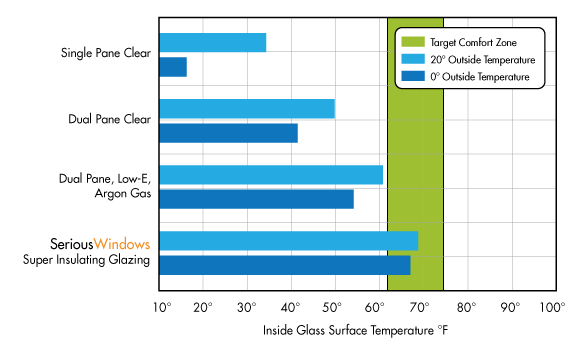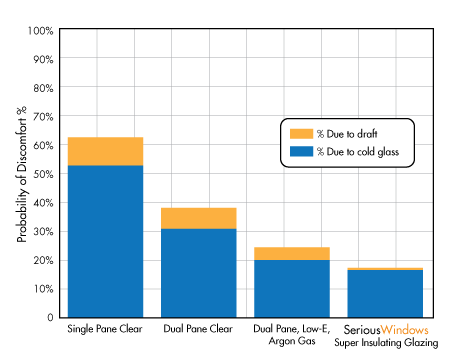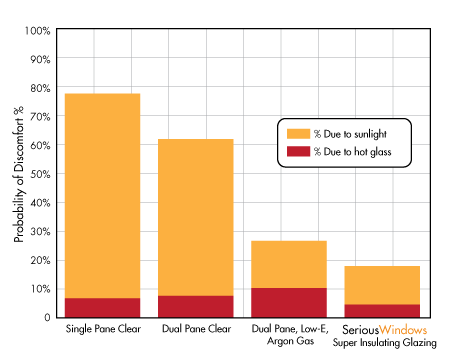Green Building Technologies
3. Insulating windows. Well, a lot of designers of office and apartment towers like to use a lot of glass. Glass allows a lot of natural sun light in. It’s great for our health. And, we don’t need so much lighting during the day and that saves electricity. But glass is terrible insulation. Builders are now using double glazing and, recently, used triple glazing. But triple glazing is extremely heavy. Did you know there are special glazing systems that have very high insulation values?
4. Heating and Cooling Systems. Ask any engineer. Since we can significantly improve the insulation of a building, the size of the heating and cooling systems can be significantly decreased (saving costs) while maintaining the same level of comfort for the tenants or inhabitants.
5. Ventilation. The integrated design approach must take into careful consideration how the air flows throughout the building so the cooled or heated air is circulated properly to maintain optimal comfort levels for the people working or living inside the building.
6. Indoor Air Quality. Did you know there are buildings being built today with filtration systems that provide very high quality air in the buildings. In fact, some buildings profess that the people who work or live inside the buildings breathe air that is cleaner than the air outside. In fact, the air that is ventilated back outside is even cleaner than the air in the atmosphere so they advertise their building as a huge air filter for the city in which they are located.
7. Preservation of water. Water is increasingly becoming a scarce resource so we must decrease the use of water in buildings. Collection and storage of rainwater and grey water should be considered for use in flushing toilets or watering plants. Waterless urinals and toilets are becoming increasingly popular as the technology improves.
8. Renewable Energies. Solar can be used to produce electricity. Solar can also be used to heat water. And some wind energy applications can also be applied. Unless you have unique locations like the Masdar HQ building in Abu Dhabi, where they are using a lot of solar technology to generate almost 50% of the required energy, applications for solar and wind in buildings are limited, in my personal view.
9. Geothermal. I am not talking about digging several miles or kilometers deep into the ground to tap geothermal heat to generate turbines. I am talking about simple geothermal applications such as heat exchange systems. These applications can be very cheap and effective methods of heating the building in the winter and cooling in the summer.
10. Other green building technologies. For example, passive and active energy systems.
Understanding Windows to Improve Energy Performance
Comfort Benefits
The comfort of your home during both winter and summer months can be largely dependent on your windows. Older single pane windows, dual pane windows, and even gas filled double pane windows often do not provide enough insulation to maintain a comfortable inside window temperature. The colder or hotter the interior glass temperature is, the more energy will be required to maintain a comfortable home temperature.
Winter Comfort: If your windows do not provide sufficient full-frame insulation performance, air may not only be leaking out of your windows, but also, as the interior glass temperature of a window becomes colder, it cools the air next to it. The cooled air then drops to the floor because cold air is heavier than warm air and more warm air moves in, close to the cold window that is then cooled. This process creates a cold air circulation that causes a draft and leads to a large amount of heat loss.
SeriousWindows can provide nearly unbeatable interior window temperatures, even in zero degree weather. On average, our windows maintain an interior temperature of 65 to 70 degrees even in the coldest of winters. Because the interior temperature of our windows is so high, it virtually eliminates that drafty cold air feeling that you would get from most other windows. The warm interior temperature of our windows also reduces the amount of cold air circulation caused by cold glass and therefore can drop your heating use dramatically.
Summer Comfort: In the summer, direct sunlight creates a warm interior glass temperature that causes overheating and discomfort. The same draft problem that occurs in the winter also occurs in the summer, but in a reverse effect. The warm interior glass temperature warms the air next to the window and causes it to rise. The cooled air from your air conditioner moves in next to the window and the cycle begins again. The air that is heated by the warm interior glass temperature counteracts the cooling effects of your homes air conditioner, creating hot spots in your home and driving up your cooling costs.
SeriousWindows’ spectrally selective glazing reduces the solar radiation coming in through the glass that is associated discomfort without impeding light and views. SeriousWindows also maintain a consistent interior glass temperature that prevents hot air drafts and hot spots in your home for a more comfortable interior environment.
Probability of Discomfort Due to Sunlight and Hot Interior Glass Temperatures
Discomfort is most often caused by excess sunlight rather than hot glass. SeriousWindows utilizes low-E coatings to reflect excess sunlight back outdoors to maintain a more comfortable environment.
All data from the Efficient Windows Collaborative. The data used for SeriousWindows was based on an average glass package that featured a Low-E coating, gas fill, suspended film and a low or high SHG dependending on climate.
Warmer Interior Glass Temperatures Offer Greater Comfort
The green bar in the above graph represents an interior glass temperature that is considered the most comfortable. SeriousWindows offer high interor glass temperatures for improved comfort and efficiency.
Probability of Discomfort Due to Draft vs Cold Interior Glass Temperature
Discomfort is most often caused by cold interior glass temperature rather than a draft. SeriousWindows warm interior glass temperatures even in zero degree weather create a more comfortable environment.



An interesting report by CoreNet Global in collaboration with the Rocky Mountain Institute on “Reinventing Buildings”. Please click on image to read more.
Green buildings will soon become the norm!!
What makes a Green Building, "green"?
1. Integrated Design Approach. High performance buildings at affordable prices can only be achieved with an integrated design approach. For example, we need to spend more money on insulation and insulating window systems so we can save money on the heating and cooling systems. Isn’t this just common sense? And, isn’t it common sense to take advantage of the sun’s location … to position the building to take best advantage of eastern, southern, western and northern exposures?
2. Insulation. Everyone knows that the first step to building high performance buildings is to make sure you have excellent insulation. Insulation in the walls and the ceilings so that the energy is contained. For example, in the winter, we don’t want all the heat to escape. And, in the summer, we don’t want all the air conditioned air leaking out. Otherwise our boilers and air conditioners are working harder than they have to and this mean a lot of energy is wasted. So what is the best insulation materials to use? What R or U values are most appropriate?



